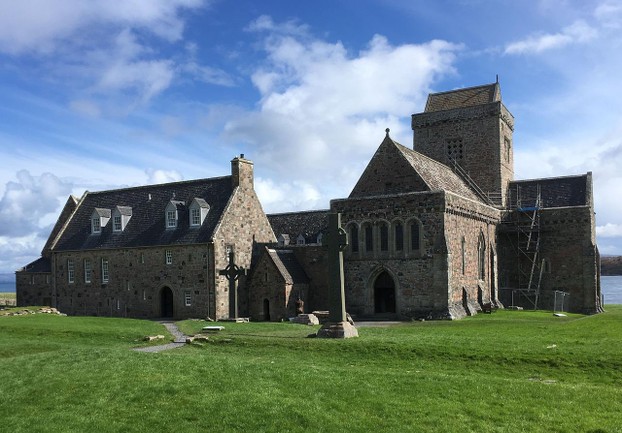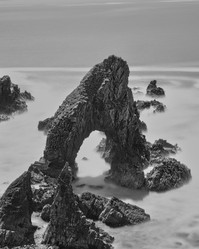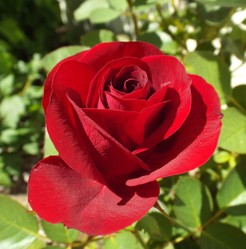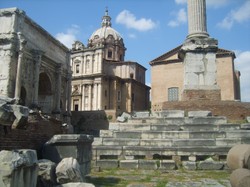I select my celebrity programs carefully. Some such shows are mind-numbing pits of triviality, but others are serious attempts at good programs. This show is high on the quality list. Seven celebrities are walking [with some necessary boat and bus journeys] from St Columba's native Donegal to Scotland's sacred isle of Iona, journeying on a voyage of growth and self-discovery through both wild and urban spaces. The pilgrimage follows a mediaeval pilgrim trail based on sites sacred to St Columba,also known as Columcille.
The celebrities are: Laurence Llewelyn Bowen, interior designer and atheist pagan; Nick Hewer, a very intelligent agnostic rethinking his position as he enters his twilight years; Scarlett Moffatt,a sensitive Christian, who became tearful when a sacred stone was not given sufficient respect; Monty Panesar, an open minded SIkh cricketer, Louisa Clein,a Jewish actor; and Shiraz Miraz, a Muslim comedienne. A seventh, Will Bayley, a paralympian table tennis star, who struggles with bodily illness, will arrive in episode two. Participants need a basic knowledge of religion, but none are scholars of any expertise in the field, and all seem to be basically tolerant of others' positions.
After first meeting in Donegal town the participants began their walk on the wave-beaten cliffs that tower on Donegal's coastline, and we were treated to sights of its wild landscape. Truly awesome. In a land containing sacred stones dating from the Neolithic age now re-christened into the Celtic Christian cultus, the ever-smart Laurence, who insisted on maintaining his sartorial elegance whatever the landscape and weather, was in his element. It was clear that he had done his homework on the route and its features.
What struck me as a religious writer was the friendly spirit in which conversations were conducted. All participants seemed determined to respect the sensitivities of the others and no-one was pushing their position or attempting to proselytise. The participants are all on a journey of discovery, some attempting to rethink their position and others to deepen it. Monty, the Sikh, is interested in finding out more about Christianity, but is ready to share his faith with others.
Monty was the first to take the pilgrims to a place of worship, a Sikh gurudwara, which proved a pleasant experience where the pilgrims enjoyed the generous hospitality of the Sikh post-worship meal, which is open to all-comers. The pilgrims were later to visit a Catholic church in Derry [Londonderry to people of Unionist persuasion] on the site of a monastery destroyed founded by St Columba and destroyed at the Reformation. Mass proved a significant experience. Scarlett asked the priest for a blessing and felt enriched by it; Monty asked for a blessing, had a brief talk about the divine energy permeating nature, and felt that the blessing had done him good. Strangely, the Jewish Louisa, who did not seek a blessing, felt that attending mass had inspired in her a yearning to attend synagogue. Something spiritual was happening, and it was not confined to any one religion.
I was left with the following thought. Starting in the mountain country of Donegal the metaphor of ascending the mountain of God is apt. There is one summit, but several routes to it. All ways must be true ways, and there are false paths, but within the true ways every path is unique to the individual who takes it.







 TheThousand Year Gardenon 11/26/2025
TheThousand Year Gardenon 11/26/2025
 Women of the Gospelson 10/11/2025
Women of the Gospelson 10/11/2025
 Religious Gardenson 08/25/2025
Religious Gardenson 08/25/2025
 Doctor of the Church: John Henry Newmanon 08/03/2025
Doctor of the Church: John Henry Newmanon 08/03/2025



Comments
My ablutions are almost entirely showers, so I don't need help at the moment. But we upgraded the bathroom so that the bath has access through a small doorl. Thus when I shower (in our combined bath and shower) i access through the bath door.? The National Health Service installed a a wall bar to help my balance when they installed an extra banister to make descending stairs safer for me
Heating pads help with just about anything because they make the blood-vessel network a bit larger so that blood moves without the obstruction of constricted vessel walls.
Somewhat related, somewhat unrelated, perhaps the one good thing about bloodletting presented itself in pressure-lowering by removing blood in quantities -- but often too large -- more than injury-constricted blood walls preferred to handle.
Hot showers realize what hot soaks realize even as they perhaps should replace the latter in the case of sore hips! (With such a slender wife, you probably would have to have help out of a tub soak from your sons were your hip to refuse to work like a well hip! [In the United States, Emergency Medical Services and Fire Department paramedics would be called!])
And a key component would be hearing or reciting Be Thou my vision!
That sounds really nice. My legs are feeling almost completely better, just a sore hip.
Heating pads and hot-water soaks to the sounds of Be thou my vision always work for me when I'm tired from hand-mowing the yard for a forest-floor look with bare soil, moss, wild flowers and fruits and grasses and herbs and without turf grass.
I pushed the walking over this weekend but now my legs are struggling. So when I finish this comment and my drink I am taking an early night in the hope that my legs will feel better.
No apologies needed.
Please accept my apologies. The question arises from my appreciation of your extensive experience with treks arduous or easy, long or short.
It also arises from my more limited experience what with being born in a state that has one hill that just makes its qualification as a ski slope -- ;-D -- and with having climbed Corcovado and Mont Sainte-Victoire, neither of them at all competitive with your British-Isles accomplishments.
Yes, but don't rely on me for walking gear. My illness is having a serious effect on my walking, so I am no longer capable of doing a long journey on foot.
A program such as this on this, western Atlantic pond side is likely to have a lot of product lines associated with it.
For example, push items might be backpacks, footwear, outwear and walking aids.
Please excuse me for materializing spiritual pilgrimages, particularly since elsewhere I questioned you and Veronica about what you and your respective spouses don in the way of trekking/walking footwear.
Were the participants consistent with what you and your wife, Veronica and her husband would have donned in the way of backpacks, footwear, outerwear and walking aids (such as walking-sticks)?
No, there has not been.